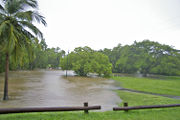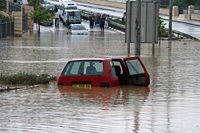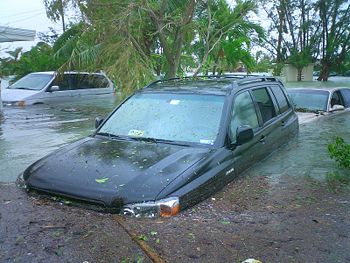Flood
2008/9 Schools Wikipedia Selection. Related subjects: Climate and the Weather; Natural Disasters
A flood is an overflow of an expanse of water that submerges land, a deluge. In the sense of "flowing water", the word is applied to the inflow of the tide, as opposed to the outflow or "ebb".
It is usually due to the volume of water within a body of water, such as a river or lake, exceeding the total capacity of the body, and as a result some of the water flows or sits outside of the normal perimeter of the body. It can also occur in rivers, when the strength of the river is so high it flows right out of the river channel , usually at corners or meanders. These of course, are not applicable in such instances as sea flooding.
The word comes from the Old English flod, a word common to Teutonic languages, compare German Flut, Dutch vloed from the same root as is seen in flow, float.
The term "The Flood" usually refers to the great Universal Deluge described in Genesis and is treated at Deluge.
Principal types of flood
Riverine floods

- Slow kinds: A large quantity of rainfall or snowmelt navigated to a river at a too rapid speed for the river to cope. These floods mainly occur in monsoon areas, where there is high precipitation.
- Fast kinds: flash flood as a result of e.g. an intense thunderstorm.
Estuarine floods
- Commonly caused by a combination of sea tidal surges caused by storm-force winds.
Coastal floods
- Caused by severe sea storms, or as a result of another hazard (e.g. tsunami or hurricane).
Catastrophic floods
- Caused by e.g. dam breakage, or as a result of another hazard (e.g. earthquake or volcanic eruption).
Other
- Flooding can occur if water accumulates across an impermeable surface (e.g. from rainfall) and cannot rapidly dissipate (i.e. gentle orientation or low evaporation).
Typical effects
Primary effects
- Physical damage- Can range anywhere from bridges, cars, buildings, sewer systems, roadways, canals and any other type of structure.
- Casualties- People and livestock die due to drowning. It can also lead to epidemics and diseases.
Secondary effects
- Water supplies- Contamination of water. Clean drinking water becomes scarce.
- Diseases- Unhygienic conditions. Spread of water-borne diseases
- Crops and food supplies- Shortage of food crops can be caused due to loss of entire harvest.
Tertiary/long-term effects
- Economic- Economic hardship, due to: temporary decline in tourism, rebuilding costs, food shortage leading to price increase etc, especially to the poor.
Flood defences, planning, and management
In western countries, rivers prone to floods are often carefully managed. Defences such as levees, bunds, reservoirs, and weirs are used to prevent rivers from bursting their banks. Coastal flooding has been addressed in Europe with coastal defences, such as sea walls and beach nourishment.
London is protected from flooding by a huge mechanical barrier across the River Thames, which is raised when the water level reaches a certain point (see Thames Barrier).
Venice has a similar arrangement, although it is already unable to cope with very high tides. The defenses of both London and Venice will be rendered inadequate if sea levels continue to rise.
The largest and most elaborate flood defenses can be found in the Netherlands, where they are referred to as Delta Works with the Oosterschelde dam as its crowning achievement. These works were built in response to the North Sea flood of 1953 of the southwestern part of the Netherlands. The Dutch had already built one of the world's largest dams in the north of the country: the Afsluitdijk (closing occurred in 1932).

Currently the Saint Petersburg Flood Prevention Facility Complex is to be finished by 2008, in Russia, to protect Saint Petersburg from storm surges. It also has a main traffic function, as it completes a ring road around Saint Petersburg. Eleven dams extend for 25.4 kilometres and stand eight metres above water level.
The New Orleans Metropolitan Area, 35% of which sits below sea level, is protected by hundreds of miles of levees and flood gates. This system failed catastrophically during Hurricane Katrina in the City Proper and in eastern sections of the Metro Area, resulting in the inundation of approximately 50% of the Metropolitan area, ranging from a few inches to twenty feet in coastal communities.
In an act of successful flood prevention, the Federal Government of the United States offered to buy out flood-prone properties in the United States in order to prevent repeated disasters after the 1993 flood across the Midwest. Several communities accepted and the government, in partnership with the state, bought 25,000 properties which they converted into wetlands. These wetlands act as a sponge in storms and in 1995, when the floods returned, the government didn't have to expend resources in those areas.
In China, flood diversion areas are rural areas that are deliberately flooded in emergencies in order to protect cities .
(See Crossing the Lines)
Benefits of flooding
There are many disruptive effects of flooding on human settlements and economic activities. However, flooding can bring benefits, such as making soil more fertile and providing nutrients in which it is deficient. Periodic flooding was essential to the well-being of ancient communities along the Tigris-Euphrates Rivers, the Nile River, the Indus River, the Ganges and the Yellow River, among others. The viability for hydrological based renewable sources of energy is higher in flood prone regions.

